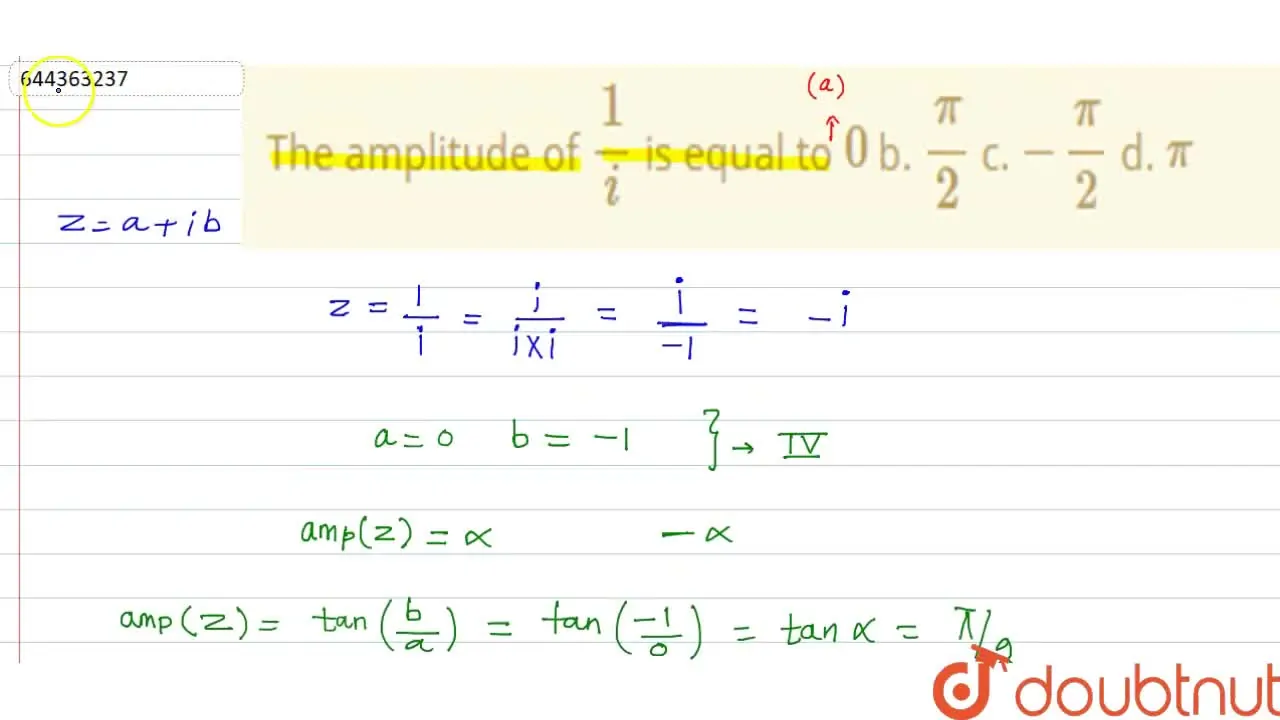The amplitude of 1i is equal to 0 b. π2 c. −π2 d. π
0
π2
−π2
π
The correct Answer is:D
Step by step video & image solution for The amplitude of 1/i is equal to 0 b. pi/2 c. -pi/2 d. pi by Maths experts to help you in doubts & scoring excellent marks in Class 12 exams.
Related Playlists
- BOOK - AAKASH INSTITUTE ENGLISHCHAPTER - COMPLEX NUMBERS AND QUADRATIC EQUATIONSEXERCISE - Assignment (Section -B) (objective Type Questions ( one option is correct)78videos
COMPLEX NUMBERS AND QUADRATIC EQUATIONS
- BOOK - AAKASH INSTITUTE ENGLISHCHAPTER - COMPLEX NUMBERS AND QUADRATIC EQUATIONSEXERCISE - Assignment (Section -C) (objective Type Questions ( more thena one options are correct )35videos
COMPLEX NUMBERS AND QUADRATIC EQUATIONS
- BOOK - AAKASH INSTITUTE ENGLISHCHAPTER - COMPLEX NUMBERS AND QUADRATIC EQUATIONSEXERCISE - Try Yourself60videos
COMPLEX NUMBERS AND QUADRATIC EQUATIONS
- BOOK - AAKASH INSTITUTE ENGLISHCHAPTER - BINOMIAL THEOREMEXERCISE - Assignment (section-J) Objective type question (Aakash Challengers Questions)4videos
BINOMIAL THEOREM
- BOOK - AAKASH INSTITUTE ENGLISHCHAPTER - CONIC SECTIONSEXERCISE - SECTION - J ( Aakash Challengers Questions )16videos
CONIC SECTIONS
Similar Questions
The amplitude of 1i is equal to
a. 0 b. π2 c. −π2 d. πView SolutionThe principal value of the amplitude of (1+i) is
A. π
B. π12
C. π4
D. 3π4View SolutionThe amplitude of 1+i√3√3+i is a. π3 b. −π3 c. π6 d. −π6
View SolutionThe argument of 1−i1+i is
a. −π2 b. π2 c. 3π2 d. 5π2View SolutionIf tanA=aa+1 and tanB=12a+1 then the value of A+B is: (a).0 (b). π2 (c). π3 (d). π4
View SolutionThe argument of the complex number (i2−2i) is equal to (a)π2 (b)π4 (c)π12 (d)3π4
View SolutionThe value of ∫π015+3cosxdx is
a. π/2
b. π/4
c. 0
d. π/8View SolutionThe value of cos−1(−1)−sin−1(1) is: a. π b. π2 c. 3π2 d. −3π2
View SolutionIf xcosy+ycosx=π then the value of y0 is equal to π (b) −π (c) 1 (d) 0
View SolutionIf xcosy+ycosx=π then the value of y''(0) is equal to π (b) −π (c) 1 (d) 0
View Solution


